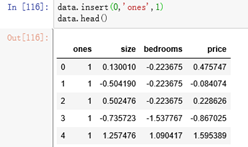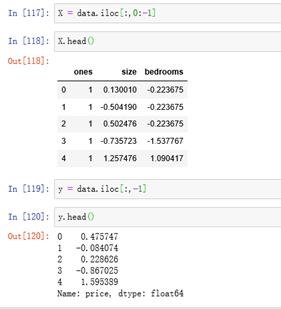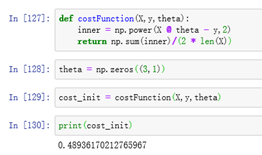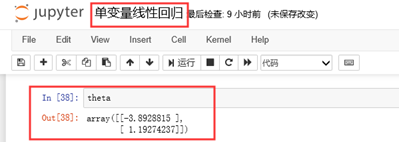吴恩达机器学习课后习题01-线性回归(01-linear regression)
切记!!!下载第一次课后作业的题目和数据包ex1data1.txt和ex1data2.txt,数据包一定要下载,并且导入到项目所在文件夹,用Ancona或者pycharm编译都可以成功!
(后续会慢慢补充并且完善线性回归知识点)
一、单变量线性回归
训练集,拟合(假设,陈述,代价函数),梯度下降法
损失函数,梯度下降函数,维度
案例:假设你是一家餐厅的CEO,正在考虑开一家分店,根据该人口数据测试其利润。
我们拥有不同城市对应的人口数据以及利润:ex1data1.txt
# 读取文件:
import numpy as np
import pandas as pd
import matplotlib.pyplot as plt
data = pd.read_csv('ex1data1.txt',names = ['population','profit'])
data.head()
data.tail()
data.describe()
data.info()


# 数据集准备:
data.plot.scatter('population','profit',label = 'population')
plt.show()
data.insert(0,'ones',1)
data.head()
X = data.iloc[:,0:-1]
X.head()
y = data.iloc[:,-1]
y.head()
X = X.values
X.shape
y = y.values
y.shape


# 损失函数:
y = y.reshape(97,1)
y.shape
def costFunction(X,y,theta):
inner = np.power(X @ theta - y,2)
return np.sum(inner)/(2 * len(X))
theta = np.zeros((2,1))
theta.shape
cost_init = costFunction(X,y,theta)
print(cost_init)

# 梯度下降函数:
def gradientDescent(X,y,theta,alpha,iters):
costs = []
for i in range(iters):
theta = theta - (X.T @ (X@theta - y)) * alpha/len(X)
cost = costFunction(X,y,theta)
costs.append(cost)
if i % 100 == 0:
print(cost)
return theta,costs
alpha = 0.02
iters = 2000
theta,costs = gradientDescent(X,y,theta,alpha,iters)

# 可视化损失函数:
fig,ax = plt.subplots()
ax.plot(np.arange(iters),costs)
ax.set(xlabel = 'iters',
ylabel = 'cost',
title = 'cost vs iters')
plt.show()
fig,ax = plt.subplots(2,3)
ax1 = ax[0,0]
ax1.plot
plt.show()

# 拟合函数可视化:
x = np.linspace(y.min(),y.max(),100)
y_ = theta[0,0] + theta[1,0] * x
fig,ax = plt.subplots()
ax.scatter(X[:,-1],y,label = 'training data')
ax.plot(x,y_,'r',label = 'predict')
ax.legend()
ax.set(xlabel = 'populaition',
ylabel = 'profit')
plt.show()

二、多变量线性回归
数据预处理(特征归一化、标准化、最大最小值),正规方程,梯度下降和正规方程比较
案例:假设你现在打算卖房子,想知道房子能卖多少钱?
我们拥有房子面积和卧室数量以及房子价格之间的对应函数数据:ex1data2.txt
# 读取文件:
import numpy as np
import pandas as pd
import matplotlib.pyplot as plt
data = pd.read_csv('ex1data2.txt',names = ['size','bedrooms','price'])
data.head()

# 特征归一化;
def normalize_feature(data):
return (data - data.mean()) / data.std()
data = normalize_feature(data)
data.head()

# 构造数据集:
data.plot.scatter('size','price',label = 'size')
plt.show()
data.plot.scatter('bedrooms','price',label = 'bedrooms')
plt.show()

# 添加全为1的列:
data.insert(0,'ones',1)
data.head()

# 构造数据集:
X = data.iloc[:,0:-1]
X.head()
y = data.iloc[:,-1]
y.head()

# 将dataframe转成数组:
X = X.values
X.shape
y = y.values
y.shape
y = y.reshape(47,1)
y.shape

# 损失函数:
def costFunction(X,y,theta):
inner = np.power(X @ theta - y,2)
return np.sum(inner)/(2 * len(X))
theta = np.zeros((3,1))
cost_init = costFunction(X,y,theta)
print(cost_init)

# 梯度下降函数:
def gradientDescent(X,y,theta,alpha,iters):
costs = []
for i in range(iters):
theta = theta - (X.T @ (X@theta - y)) * alpha/len(X)
cost = costFunction(X,y,theta)
costs.append(cost)
if i % 100 == 0:
print(cost)
return theta,costs
# 不同alpha下的迭代效果:
candinate_alpha = [0.0003,0.003,0.03,0.0001,0.001,0.01]
iters = 2000
fig,ax = plt.subplots()
for alpha in candinate_alpha:
_,costs = gradientDescent(X,y,theta,alpha,iters)
ax.plot(np.arange(iters),costs,label = alpha)
ax.legend()
ax.set(xlabel = 'iters',
ylabel = 'cost',
title = 'cost vs iters')
plt.show()

三、正规方程

import numpy as np
import pandas as pd
import matplotlib.pyplot as plt
data = pd.read_csv('ex1data1.txt',names = ['population','profit'])
data.insert(0,'ones',1)
X = data.iloc[:,0:-1]
y = data.iloc[:,-1]
X = X.values
y = y.values
y = y.reshape(97,1)
X.shape
y.shape
def normalEquation(X,y):
theta = np.linalg.inv(X.T@X)@X.T@y
return theta
theta = normalEquation(X,y)
print(theta)

四、附录
完整代码:
单变量
# 读取文件
import numpy as np
import pandas as pd
import matplotlib.pyplot as plt
data = pd.read_csv('ex1data1.txt',names = ['population','profit'])
data.head()
data.tail()
data.describe()
data.info()
# 数据集准备
data.plot.scatter('population','profit',label = 'population')
plt.show()
data.insert(0,'ones',1)
data.head()
X = data.iloc[:,0:-1]
X.head()
y = data.iloc[:,-1]
y.head()
X = X.values
X.shape
y = y.values
y.shape
# 损失函数
y = y.reshape(97,1)
y.shape
def costFunction(X,y,theta):
inner = np.power(X @ theta - y,2)
return np.sum(inner)/(2 * len(X))
theta = np.zeros((2,1))
theta.shape
cost_init = costFunction(X,y,theta)
print(cost_init)
# 梯度下降函数:
def gradientDescent(X, y, theta, alpha, iters):
costs = []
for i in range(iters):
theta = theta - (X.T @ (X @ theta - y)) * alpha / len(X)
cost = costFunction(X, y, theta)
costs.append(cost)
if i % 100 == 0:
print(cost)
return theta, costs
alpha = 0.02
iters = 2000
theta, costs = gradientDescent(X, y, theta, alpha, iters)
# 可视化损失函数:
fig,ax = plt.subplots()
ax.plot(np.arange(iters),costs)
ax.set(xlabel = 'iters',
ylabel = 'cost',
title = 'cost vs iters')
plt.show()
fig,ax = plt.subplots(2,3)
ax1 = ax[0,0]
ax1.plot
plt.show()
# 拟合函数可视化:
x = np.linspace(y.min(),y.max(),100)
y_ = theta[0,0] + theta[1,0] * x
fig,ax = plt.subplots()
ax.scatter(X[:,-1],y,label = 'training data')
ax.plot(x,y_,'r',label = 'predict')
ax.legend()
ax.set(xlabel = 'populaition',
ylabel = 'profit')
plt.show()

多变量
# 读取文件:
import numpy as np
import pandas as pd
import matplotlib.pyplot as plt
data = pd.read_csv('ex1data2.txt',names = ['size','bedrooms','price'])
data.head()
# 特征归一化;
def normalize_feature(data):
return (data - data.mean()) / data.std()
data = normalize_feature(data)
data.head()
# 构造数据集:
data.plot.scatter('size','price',label = 'size')
plt.show()
data.plot.scatter('bedrooms','price',label = 'bedrooms')
plt.show()
# 添加全为1的列:
data.insert(0,'ones',1)
data.head()
# 构造数据集:
X = data.iloc[:,0:-1]
X.head()
y = data.iloc[:,-1]
y.head()
# 将dataframe转成数组:
X = X.values
X.shape
y = y.values
y.shape
y = y.reshape(47,1)
y.shape
# 损失函数:
def costFunction(X,y,theta):
inner = np.power(X @ theta - y,2)
return np.sum(inner)/(2 * len(X))
theta = np.zeros((3,1))
cost_init = costFunction(X,y,theta)
print(cost_init)
# 梯度下降函数:
def gradientDescent(X, y, theta, alpha, iters):
costs = []
for i in range(iters):
theta = theta - (X.T @ (X @ theta - y)) * alpha / len(X)
cost = costFunction(X, y, theta)
costs.append(cost)
if i % 100 == 0:
print(cost)
return theta, costs
# 不同alpha下的迭代效果:
candinate_alpha = [0.0003, 0.003, 0.03, 0.0001, 0.001, 0.01]
iters = 2000
fig, ax = plt.subplots()
for alpha in candinate_alpha:
_, costs = gradientDescent(X, y, theta, alpha, iters)
ax.plot(np.arange(iters), costs, label=alpha)
ax.legend()
ax.set(xlabel='iters',
ylabel='cost',
title='cost vs iters')
plt.show()

正规方程
import numpy as np
import pandas as pd
import matplotlib.pyplot as plt
data = pd.read_csv('ex1data1.txt',names = ['population','profit'])
data.insert(0,'ones',1)
X = data.iloc[:,0:-1]
y = data.iloc[:,-1]
X = X.values
y = y.values
y = y.reshape(97,1)
X.shape
y.shape
def normalEquation(X,y):
theta = np.linalg.inv(X.T@X)@X.T@y
return theta
theta = normalEquation(X,y)
print(theta)
